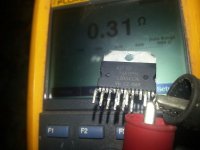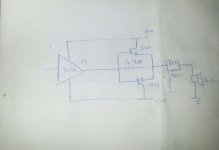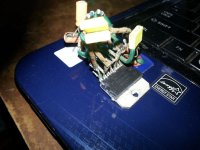Hi,
I have just purchased a stereo 7294 board that required me to add a heatsink, which I did!
The amp was working well for quite a while until I touched the heatsink to check the temperature. There was a flash, bang and a plume of smoke.
On checking the blown chip I noticed that I had not installed the mica insulator quite parallel the the chip body.
Winters are very dry here and static shocks are regular when touching a water tap or radiator. Is it possible that when I touched the heatsink a spark jumped the gap between it and the chip where there was no insulation?
Thanks.
I have just purchased a stereo 7294 board that required me to add a heatsink, which I did!
The amp was working well for quite a while until I touched the heatsink to check the temperature. There was a flash, bang and a plume of smoke.
On checking the blown chip I noticed that I had not installed the mica insulator quite parallel the the chip body.
Winters are very dry here and static shocks are regular when touching a water tap or radiator. Is it possible that when I touched the heatsink a spark jumped the gap between it and the chip where there was no insulation?
Thanks.
....Is it possible that when I touched the heatsink a spark jumped the gap between it and the chip where there was no insulation?.....
I doubt it. However it might have caused a spike on the ground line killing the chip. This chip IS sensitive to anything beyond what they strictly specify. So maybe lifting the ground momentarily caused something to blow on the chip.
Remember that the spark is between the hand and the heatsink. However it could cause a momentary disastrous voltage spike on the ground line !
Last edited:
Could this be a case of fake TDA7294?
Mine was purchased Locally in December, Used for 4ohm 12" Subwoofer with 2sc5200/1943 boosters.
It sounded pretty powerful and satisfactory with 36-0-36 volts dc input and a generous heatsink.A day of operation would make it warm(I can keep my hands on Heatsink without any casuality. viz50-60 degree celcius)
Approximately after 5 weeks there was only a loud buzz in woofer .I desoldered the chip and found output pin 13 and pin 15 has shorted. Output transistors are still intact.
Mine was purchased Locally in December, Used for 4ohm 12" Subwoofer with 2sc5200/1943 boosters.
It sounded pretty powerful and satisfactory with 36-0-36 volts dc input and a generous heatsink.A day of operation would make it warm(I can keep my hands on Heatsink without any casuality. viz50-60 degree celcius)
Approximately after 5 weeks there was only a loud buzz in woofer .I desoldered the chip and found output pin 13 and pin 15 has shorted. Output transistors are still intact.
It depends on where you purchased it, if you bought it from TayDay in china, or some place like that then all bets are off. Even local suppliers can bulk purchase these from places like this for peanuts, and you get fakes. Ideally you want a reputable supplier.
But the TDA7294 in itself is an overly sensitive component. I have seen many amplifiers and subwoofers built around that IC, even Bose, failed with no rhyme or reason as to why. One minute they work, and the next minute they spontaneously combust and I have seen something as simple as a power-on transition explode these ICs. I stayed away from this IC and avoided it like the plague. That goes with most of STs products.
But the TDA7294 in itself is an overly sensitive component. I have seen many amplifiers and subwoofers built around that IC, even Bose, failed with no rhyme or reason as to why. One minute they work, and the next minute they spontaneously combust and I have seen something as simple as a power-on transition explode these ICs. I stayed away from this IC and avoided it like the plague. That goes with most of STs products.
Last edited:
It depends on where you purchased it, if you bought it from TayDay in china, or some place like that then all bets are off. Even local suppliers can bulk purchase these from places like this for peanuts, and you get fakes. Ideally you want a reputable supplier.
But the TDA7294 in itself is an overly sensitive component. I have seen many amplifiers and subwoofers built around that IC, even Bose, failed with no rhyme or reason as to why. One minute they work, and the next minute they spontaneously combust and I have seen something as simple as a power-on transition explode these ICs. I stayed away from this IC and avoided it like the plague. That goes with most of STs products.
Thanks for quick response.
I have used a power on transistor at mute pin for soft start and quick turn off.
Is there a way to identify fake TDA7294 from the batch code ,I have tested pin 11 and 12 method.?
Attachments
Last edited:
Where do you take your drive for the power transistors ? A single resistor from the 7294 output or two resistors one on each the supply rail ?
If it's the latter , you are in a position that any glitch on the output 'could' cause failure.
This is how power transistors are configured.
It worked 5 weeks perfectly,went off while turning on next day( so no thermal runaway or short circuits.)
Attachments
It is easier to identify a real TDA7293 because all 15 pins work in the real thing.
Problematically, the datasheet schema for TDA7293/4/5/6 tends to make them under-perform and eventually quit.
Suggestion: Treat the fake TDA7294 as if TDA7296--much lower power voltage.
Problematically, the datasheet schema for TDA7293/4/5/6 tends to make them under-perform and eventually quit.
Suggestion: Treat the fake TDA7294 as if TDA7296--much lower power voltage.
Last edited:
......went off while turning on next day.........
Your output stage is OK and the rails of your input and output must be connected directly. So one possibility is that your supply rails didn't come up together ( or go down together when last switched off ....maybe like power off when music is playing loud !). I think the chip is sensitive to this.
Wish Ilimzn is reading this. You could search for him and send him a message. He understands this chip well.
I'm thinking of the TDA7297's datasheet, which is an epic prank because it is accurate and that is not normal. This wasted a huge amount of time because I tried everything else first.
Generally, with power-op-amp chips, the datasheet schematics are of no practical value and could cause breakage. I don't know why that is.
The matter is even worse in the case of fakes, which could work delightfully at FAR smaller scale and a lot less voltage. Those are hard to identify, and I wish they had their own datasheets. I also wish the datasheets would have accurate schematics. However!
The chip manufacturers seem to have done awfully well; however, the datasheet authors probably need spanked.
Generally, with power-op-amp chips, the datasheet schematics are of no practical value and could cause breakage. I don't know why that is.
The matter is even worse in the case of fakes, which could work delightfully at FAR smaller scale and a lot less voltage. Those are hard to identify, and I wish they had their own datasheets. I also wish the datasheets would have accurate schematics. However!
The chip manufacturers seem to have done awfully well; however, the datasheet authors probably need spanked.
Wow! Mark, that's really important, especially in case of the LM1875, since the inbuilt protection does not work practically. Also, in case of the fake TDA7294's the protection circuits do not work (except if the PSU could not blow the amp). Like a discrete amplifier, if the PSU has more wattage capacity than the amplifier, then I think it will break by request. Such is linear tech. It is, indeed, linear.The current would only be limited by the PSU.
A real TDA7293/4/5/6 will cut off the bass instead of break, but the fake will break (by request).
Last edited:
Your output stage is OK and the rails of your input and output must be connected directly. So one possibility is that your supply rails didn't come up together ( or go down together when last switched off ....maybe like power off when music is playing loud !). I think the chip is sensitive to this.
Wish Ilimzn is reading this. You could search for him and send him a message. He understands this chip well.
My power supply is conventional single bridge diode dual power supply with 10000uf on each rail.So chances of one end failure is least moreover there is 2200uf near the chip onboard.
I doubt chip is too sensitive.
I doubt if it happened through mute pin? in order to prevent the on/off pop I used a bc556 biased from trafo AC side of secondary followed by in4i48 and 10k resistor/22uf.I may have to draw the schematic and post ,if required.
OTOH I have TDA7294 running since last 7 years in my friends house,which was made by me. but it does not have soft start controls,just ST datasheet circuit.
This below in pic, my first. worked for 4 years and still good though I don't play it anymore .
Attachments
Last edited:
Thanks for the replies.
This particular stereo board has the rectifier, soft start and speaker protection built in. I just added a 22-0-22v transformer and a heatsink.
I get the feeling now it was an isolation problem that caused the chip to blow, leg 7 must have got very hot, the board was burnt. The other channel is still working
The smell of burning remained in the house for hours, reminded me of grilled Kippers.
This particular stereo board has the rectifier, soft start and speaker protection built in. I just added a 22-0-22v transformer and a heatsink.
I get the feeling now it was an isolation problem that caused the chip to blow, leg 7 must have got very hot, the board was burnt. The other channel is still working
The smell of burning remained in the house for hours, reminded me of grilled Kippers.
Wow! Mark, that's really important, especially in case of the LM1875, since the inbuilt protection does not work practically. Also, in case of the fake TDA7294's the protection circuits do not work (except if the PSU could not blow the amp). Like a discrete amplifier, if the PSU has more wattage capacity than the amplifier, then I think it will break by request. Such is linear tech. It is, indeed, linear.
A real TDA7293/4/5/6 will cut off the bass instead of break, but the fake will break (by request).
Pin 8 or 15 is connected to the tab of the chip, if the tab is short to ground you get instant discharge of the PSU caps, there is no build in protection for that. Its not a slow heat, its a flash and a bang.
Last edited:
Thanks Mark. Yes, that's right, pin 8 is 1:1 with the tab and pin 15 is diodic with the tab. Momentarily loading the tab with something ground-ish would drive pin 8 to a smaller negative voltage figure than pin 15, reverse charge the parasitic diode and instantly shatter the substrate. The failure mode is pretty much like the mistake of reverse volting an led resulting in instant breakage, except the chip smells much worse. In the case of static discharge into the tab, the substrate can shatter even if pin 8 is directly wired to pin15 by solid copper or a schottky.
So, good isolated mount of that chip is critical. But, not really easy.
Where can we find some generously oversize thermal pads for these chip amps? The commonplace TO3P and TO264 pads are a bit too sketchy for a chip amp held by one screw since it can so easily slip over that tiny bit of margin.
So, good isolated mount of that chip is critical. But, not really easy.
Where can we find some generously oversize thermal pads for these chip amps? The commonplace TO3P and TO264 pads are a bit too sketchy for a chip amp held by one screw since it can so easily slip over that tiny bit of margin.
Last edited:
Thanks,Don't forget to insulate the screw to.
If people have been listening to AndrewT's good advice, the chassis and heatsink will be connected to ground.
I did have sleeves on the screws.
I have found the following on the Forum and the mention of how these chips can be ruined by an electrostatic charge. I'm hoping this is the problem.
I have been building TDA7294 boards from time to time for several years now. Here goes some advice:
- Check for solderballs, solder bridges or bad soldering.
- Never solder a replacement chip without some heatsink attached, the heat applied to the pins will destroy it most times. Otherwise, you will have to solder the pins one by one leaving gentle time inbetween to prevent excess heat to build up.
- Even whith the heatsink attached, allow a few seconds for the chip to cool down after soldering each group of three or four pins or so.
- Replace the small electrolytic capacitors related to the chip, particularly the bootstrap one. They cost very little, yet they can cause new chips to blow instantaneously if they are faulty.
- The chip may blow if MUTE or STANDBY inputs are left "floating".
- Never remove the RC output cell, doing so may cause instability and ultimately destroy the IC.
- Be aware that a new chip may be partially damaged due to excess soldering heat or electrostatic discharge and it will fail after a few hours or days of operation. TDA7294 seemed to be quite a delicate IC ultil it's mounted in a PCB.
I'm thinking of the TDA7297's datasheet, which is an epic prank because it is accurate and that is not normal. This wasted a huge amount of time because I tried everything else first.
Generally, with power-op-amp chips, the datasheet schematics are of no practical value and could cause breakage. I don't know why that is.
The matter is even worse in the case of fakes, which could work delightfully at FAR smaller scale and a lot less voltage. Those are hard to identify, and I wish they had their own datasheets. I also wish the datasheets would have accurate schematics. However!
The chip manufacturers seem to have done awfully well; however, the datasheet authors probably need spanked.
Could it be that there are no "Fakes", just chips that have been handled without regard to their very high sensitivity to ESD?
From what I have read, static does not always kill the chip immediately, it can shorten it's life and/or effect it's performance.
- Status
- This old topic is closed. If you want to reopen this topic, contact a moderator using the "Report Post" button.
- Home
- Amplifiers
- Chip Amps
- 7294 chip went bang???


